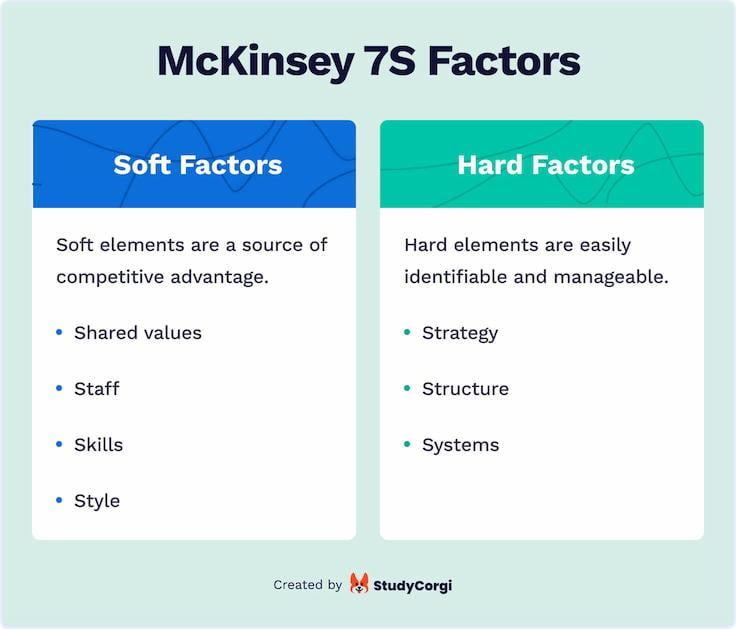📌 How to Use McKinsey 7S Model Template
By using our 7S model template, you can get a well-designed diagram for your report in several simple steps:
- Add the data. The information you will need includes the 7 aspects of your company according to the McKinsey framework.
- Choose the design. We offer many elegant design styles —pick the one that suits you best.
- Download the result. You can get your custom diagram in the required format.
🎓 McKinsey 7S Model Explained
The McKinsey 7S model is a change management framework developed in the 1980s by McKinsey & Company. It contains seven elements that managers should evaluate when preparing the company for organizational change. These components include Shared Values, Strategy, Structure, Skills, Style, Staff, and Systems.
A manager’s task is to assess how well the firm performs in each area and whether there are any inconsistencies between them. The model shows that a change in one organizational aspect will inevitably influence other fields.
What are the 7S Factors?
The 7S factors in the McKinsey 7S matrix are the internal factors affecting organizational performance. They are divided into hard and soft ones.

Hard elements are easily identifiable and manageable. They include:
- Strategy: the company’s plan for developing and maintaining competitive advantage.
- Structure: how departments are organized within the company.
- Systems: employees’ daily activities and procedures.
Soft elements are more challenging to manage than hard ones but are a source of sustainable competitive advantage. Soft factors include:
- Style: leadership styles used.
- Staff: employees and HR practices.
- Skills: employees’ skills and competencies.
- Shared values: core values reflecting the organization’s work ethics.
How to Apply the 7S Method?
The McKinsey 7S model is a framework for assessing how different parts of an organization interact with each other and influence business performance. So, to use the model, one should evaluate each of the seven factors in connection to others. Here is how to apply the 7S method.
| Step 1: Start with Shared Values | Do they align with the company’s structure, systems, and strategy? If not, it points to the need for change. |
|---|---|
| Step 2: Examine Hard Elements | Are systems, structure, and strategy consistent with each other? For example, does organizational structure facilitate or hinder everyday business operations? |
| Step 3: Evaluate Soft Factors | Do these elements support each other? For instance, do current employees have the skills required to do their jobs? |
📝 McKinsey 7S Framework Example
Let’s look at the McKinsey 7S framework example of McDonald’s.
| Strategy | McDonald’s cost leadership strategy supports the company’s goal of minimizing costs and maintaining its competitive advantage. |
|---|---|
| Structure | McDonald’s divisional organizational structure fosters autonomy and flexibility. It helps the company better meet the needs of its customers in different regions |
| Systems | The company has efficient operations, which allow it to maintain its competitive advantage of velocity. |
| Shared Values | McDonald’s core values include Family, Community, Integrity, Inclusion, and Serve. They help the company align its operations with its social and commercial goals. |
| Skills | The company regularly holds workshops and training to improve employees’ competencies. |
| Style | McDonald’s participative leadership style allows for collecting feedback from employees. It serves as a source of ideas for improvement. |
| Staff | The firm has about 200,000 employees worldwide who contribute to achieving corporate goals. |
⭐ Benefits of McKinsey 7S Model Template
Do you need an aesthetic 7S framework for your company report? Give our McKinsey 7S model template a try, and you will:
- Save your time. You do not need to search for samples and create diagrams yourself. Just enter your data and select the layout — our tool will do the rest for you.
- Get a custom design. We offer several layouts and color patterns. Choose the one that suits you best.
- Keep your money. Our templates are free to download.
- Enjoy the result on any device. You can view the completed framework both in desktop and mobile modes.
- Facilitate your organizational planning. Our well-designed template will provide outstanding visual support for planning your change initiatives.
Thank you for joining us! If you are looking for other business analysis instruments, consider trying our PESTEL, SOAR, SWOT, and Porter’s 5 Forces analysis makers.
❓ FAQ
❓ What Is the 7S Method?
The 7S method is a set of 7 core elements of any organization: Structure, Shared Values, Strategy, Style, Skills, Staff, and Systems. Companies can use this framework to guide their strategic management efforts. By analyzing how these elements relate to each other within the organization, managers can predict how the firm will respond to future organizational changes.
❓ What Are the Elements of the McKinsey 7S Model?
McKinsey 7S framework has 7 elements. Strategy, Systems, and Structure are hard elements. They are easy to identify and manage. Staff, Skills, Style, and Shared Values are soft elements that are more difficult to control but are valuable for maintaining competitive advantage.
❓ What Are the Benefits of the McKinsey 7S Model?
The benefits of the McKinsey 7S framework include the following:
- Facilitated achievement of organizational objectives;
- Alignment between different departments and processes;
- Assistance in evaluating the effects of organizational change;
- Opportunities for analyzing the company’s performance gaps.